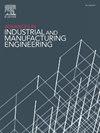Experimental investigations on the formation mechanisms of shrink lines in powder bed fusion of metals using a laser beam
Abstract
The powder bed fusion of metals using a laser beam enables the tool-free fabrication of complex part geometries with merging areas and rapid cross-sectional changes. Together, these geometry features represent a structural transition leading to the formation of shrink lines. These notches on the surface of the part reduce the dimensional accuracy and the fatigue resistance. Shrink lines arise in various materials, with the dimensions of the shrink line depending on the geometric design. The formation mechanisms and influencing parameters of shrink lines have not been investigated yet. This paper demonstrates the extent of influence of the part geometry on the shrink line formation, which was quantified by varying the design of a representative structural transition. In addition, the positions of the specimens on the build platform and the scanning strategy were varied for deriving a cause-effect relationship using process monitoring. The results demonstrated that the shrink line formation was mainly caused by a local overheating at the structural transition and the global cooling behavior. The radius at the structural transition indicated the most significant impact among the investigated geometric parameters. The shrink line dimensions depended significantly on the orientation of the specimens on the build platform and the local scanning strategy applied at the height of the structural transition. The results can be used to reduce shrink lines by re-designing the part and to adjust the manufacturing strategy for structural transitions.

 求助内容:
求助内容: 应助结果提醒方式:
应助结果提醒方式:


